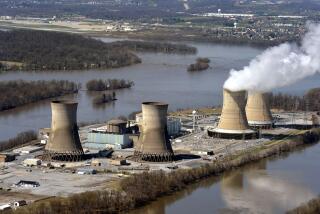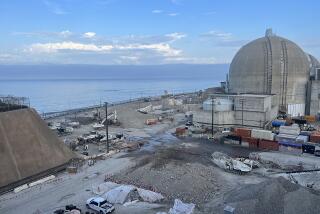Chernobyl Cleanup to Be a Long, Hazardous Task
WASHINGTON â The cleanup of the smoldering Chernobyl nuclear reactor will be daunting delicate task Ts with cameras to scout the damage, special machines to âshaveâ the radioactive walls floors workers using shovels scoops with 30-foot handles to remove bits of fuel debris.
These are some of the many devices used in the continuing cleanup at the Three Mile Island plant in Pennsylvania, which in 1979 was the site of the worst U.S. nuclear accident.
âWhat the Russians have to look forward to isnât a whole hell of a lot of fun,â said a knowledgeable U.S. nuclear power official, who asked not to be identified.
The Soviets face an even tougher job than the Three Mile Island cleanup crew: The Chernobyl explosion and at least a partial core meltdown probably produced a good deal more radiation than that released at Three Mile Island. Also, the Soviet plant had no protective containment building to hinder the spread of dangerous particles.
Once Soviet crews extinguish the plantâs blazing graphite--used in nuclear facilities of this nature--the first step on the long cleanup road will be a flooding to prevent any radioactive particles from further dispersion, said Loring Mills, vice president for nuclear activities at the Edison Electric Institute.
âThey will want to wet it down to contain it,â Mills said. He speculated that the Soviets may have smothered the fire with sand, as U.S. intelligence satellite photographs have indicated. But that would still leave radioactive particulates on the surfaces of the structure.
âDown a Dusty Roadâ
âI expect they will just plain do one heck of a long washing,â he said. âItâs like driving down a dusty road; if you wet it down, you keep the dust from flying.â
The reactor core is a block of graphite, believed to be about 70 feet in diameter and 20 feet deep, surrounded by a concrete wall. The Soviets are likely to flood the area inside the wall until the core is covered with water, which would act as an effective shield against most radiation.
Later, the water can be run through a complex filtering system to collect the radioactive particles, using the same techniques as those at Three Mile Island, Mills said.
But cleanup after any nuclear accident is a long, hard task. It was a full year before workers even ventured into the Unit 1 reactor at Three Mile Island after a loss of coolant caused extensive core damage in March, 1979.
High-Powered Sprays
High-powered water sprays were used to scourge the top layers of radioactive dust and dirt from walls and floors. But the deeply imbedded contamination could be removed only by machines with pistoned teeth that carved 1/16 of an inch from the concrete surfaces. The resulting dust was vacuumed and then sealed in steel canisters for disposal.
The Three Mile Island reactor building, meanwhile, had become a virtual rain forest from the million gallons of water pumped over the core--the water often would evaporate and then fall back again as rain. A specially designed pumping system carried the water through resins, resembling tiny beads of sand, which captured the radioactive particles.
Only after the radiation in the building was controlled could the Three Mile Island cleanup team begin work on the damaged reactor core. They got their first peek at the melted fuel through a television camera inserted into the top of the reactor in 1982.
Six Inches of Steel
Last fall, a work platform with six inches of stainless steel was erected above the reactor, whose core remains covered by 20 feet of water.
âPeople stand on the platform and work through a slot with long-handled tools,â said Gordon Tomb, a spokesman for GPU Nuclear, which operates the Three Mile Island plant. At the end of the 20- or 30-foot handles are grippers, clamps or claws, specially designed under a $15-million contract with Westinghouse, Tomb said.
The workers use their claws and grippers to chip away at the core and put the pieces in special canisters, which are also under water. Eventually, the filled casks will be shipped to Energy Department laboratories for study.
The graphite in the Chernobyl reactor is brittle and should be easier to break apart into manageable pieces than the globs of metal and ceramics fused together in the TMI core, Mills said.
Robot With a Camera
The final task at TMI will be the removal of radioactive material from the basement, the repository for all the water flooded into the building. This lower level is still so contaminated that workers are not allowed in. A primitive sort of robot, a six-wheeled vehicle with a camera, has been sent to the basement to gather information.
Cleanup of the basement is expected to be finished in 1988, Tomb said. And, after nine long years, the price will be no less than $1 billion.
More to Read
Sign up for Essential California
The most important California stories and recommendations in your inbox every morning.
You may occasionally receive promotional content from the Los Angeles Times.










